Public management system Report 2022
VerifiedAdded on 2022/08/27
|15
|4488
|13
AI Summary
Contribute Materials
Your contribution can guide someone’s learning journey. Share your
documents today.
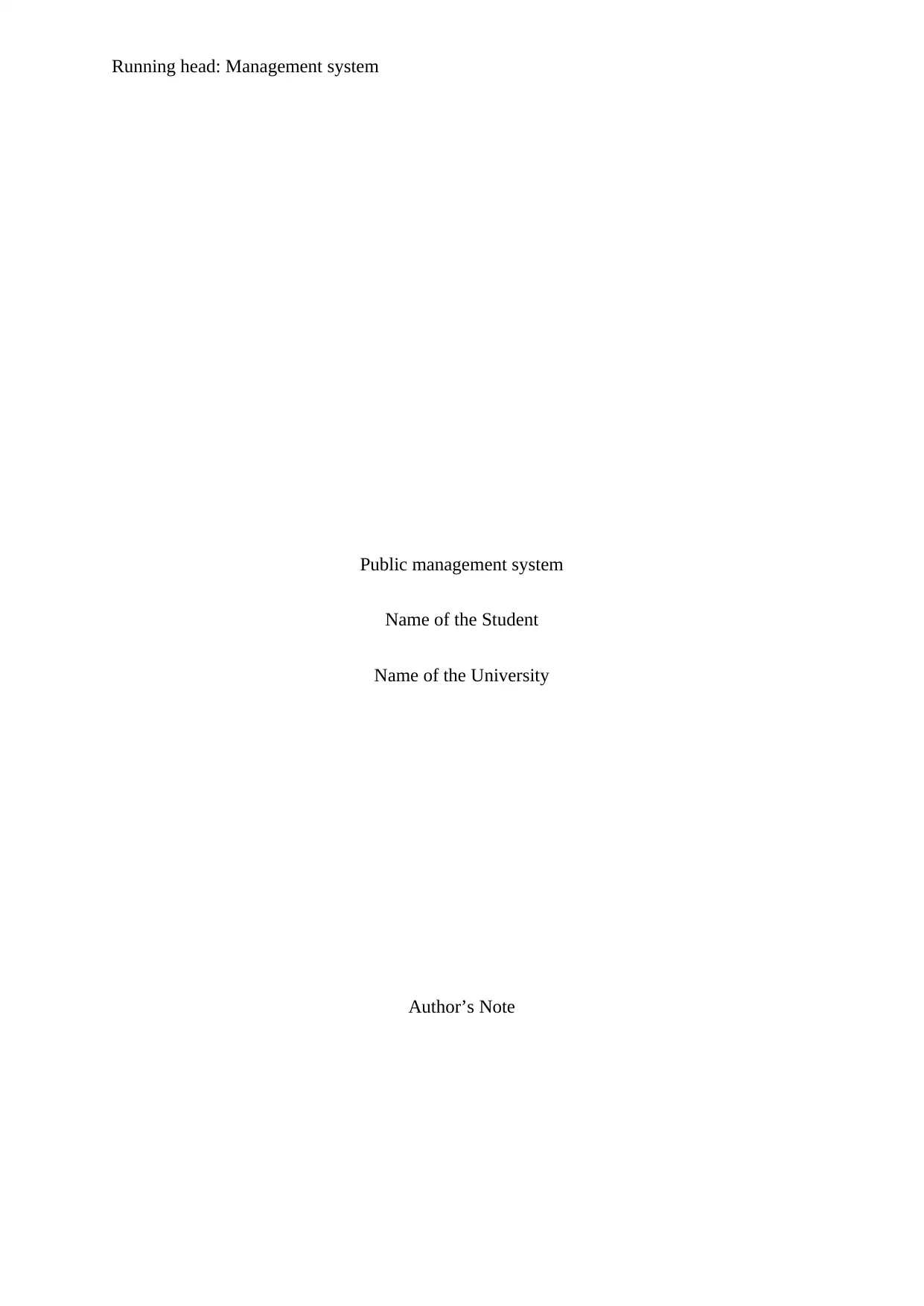
Running head: Management system
Public management system
Name of the Student
Name of the University
Author’s Note
Public management system
Name of the Student
Name of the University
Author’s Note
Secure Best Marks with AI Grader
Need help grading? Try our AI Grader for instant feedback on your assignments.
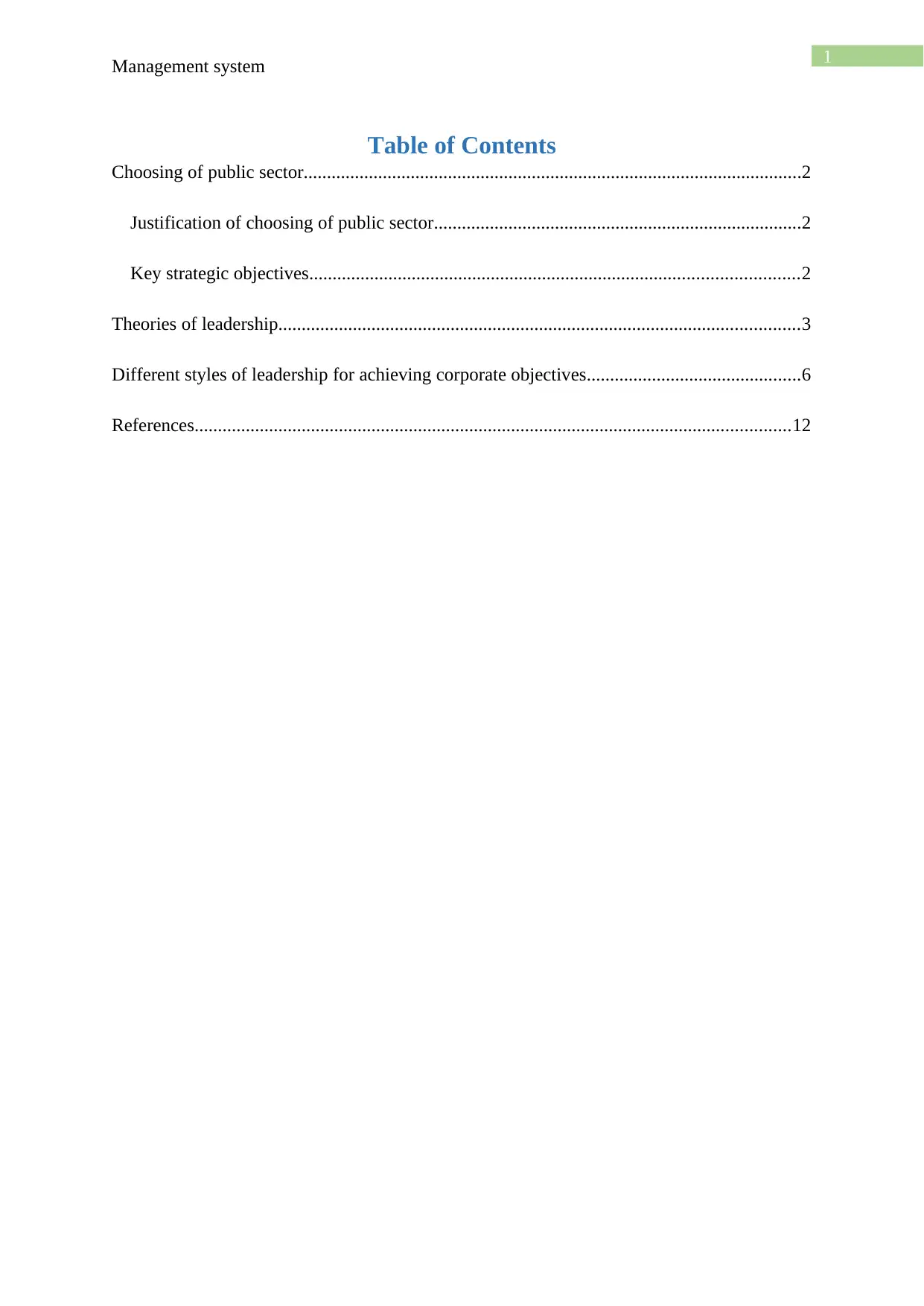
1
Management system
Table of Contents
Choosing of public sector...........................................................................................................2
Justification of choosing of public sector...............................................................................2
Key strategic objectives.........................................................................................................2
Theories of leadership................................................................................................................3
Different styles of leadership for achieving corporate objectives..............................................6
References................................................................................................................................12
Management system
Table of Contents
Choosing of public sector...........................................................................................................2
Justification of choosing of public sector...............................................................................2
Key strategic objectives.........................................................................................................2
Theories of leadership................................................................................................................3
Different styles of leadership for achieving corporate objectives..............................................6
References................................................................................................................................12
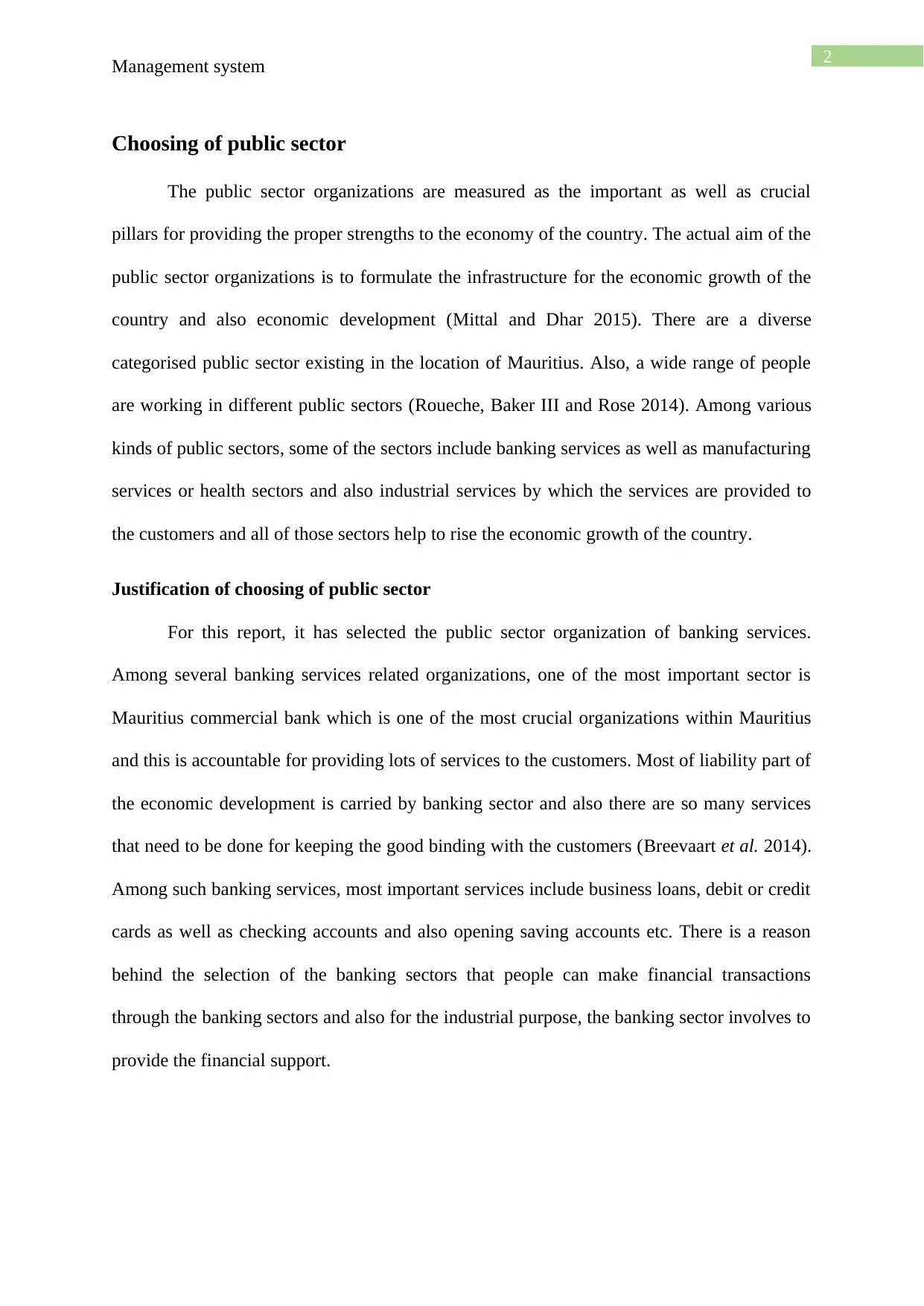
2
Management system
Choosing of public sector
The public sector organizations are measured as the important as well as crucial
pillars for providing the proper strengths to the economy of the country. The actual aim of the
public sector organizations is to formulate the infrastructure for the economic growth of the
country and also economic development (Mittal and Dhar 2015). There are a diverse
categorised public sector existing in the location of Mauritius. Also, a wide range of people
are working in different public sectors (Roueche, Baker III and Rose 2014). Among various
kinds of public sectors, some of the sectors include banking services as well as manufacturing
services or health sectors and also industrial services by which the services are provided to
the customers and all of those sectors help to rise the economic growth of the country.
Justification of choosing of public sector
For this report, it has selected the public sector organization of banking services.
Among several banking services related organizations, one of the most important sector is
Mauritius commercial bank which is one of the most crucial organizations within Mauritius
and this is accountable for providing lots of services to the customers. Most of liability part of
the economic development is carried by banking sector and also there are so many services
that need to be done for keeping the good binding with the customers (Breevaart et al. 2014).
Among such banking services, most important services include business loans, debit or credit
cards as well as checking accounts and also opening saving accounts etc. There is a reason
behind the selection of the banking sectors that people can make financial transactions
through the banking sectors and also for the industrial purpose, the banking sector involves to
provide the financial support.
Management system
Choosing of public sector
The public sector organizations are measured as the important as well as crucial
pillars for providing the proper strengths to the economy of the country. The actual aim of the
public sector organizations is to formulate the infrastructure for the economic growth of the
country and also economic development (Mittal and Dhar 2015). There are a diverse
categorised public sector existing in the location of Mauritius. Also, a wide range of people
are working in different public sectors (Roueche, Baker III and Rose 2014). Among various
kinds of public sectors, some of the sectors include banking services as well as manufacturing
services or health sectors and also industrial services by which the services are provided to
the customers and all of those sectors help to rise the economic growth of the country.
Justification of choosing of public sector
For this report, it has selected the public sector organization of banking services.
Among several banking services related organizations, one of the most important sector is
Mauritius commercial bank which is one of the most crucial organizations within Mauritius
and this is accountable for providing lots of services to the customers. Most of liability part of
the economic development is carried by banking sector and also there are so many services
that need to be done for keeping the good binding with the customers (Breevaart et al. 2014).
Among such banking services, most important services include business loans, debit or credit
cards as well as checking accounts and also opening saving accounts etc. There is a reason
behind the selection of the banking sectors that people can make financial transactions
through the banking sectors and also for the industrial purpose, the banking sector involves to
provide the financial support.
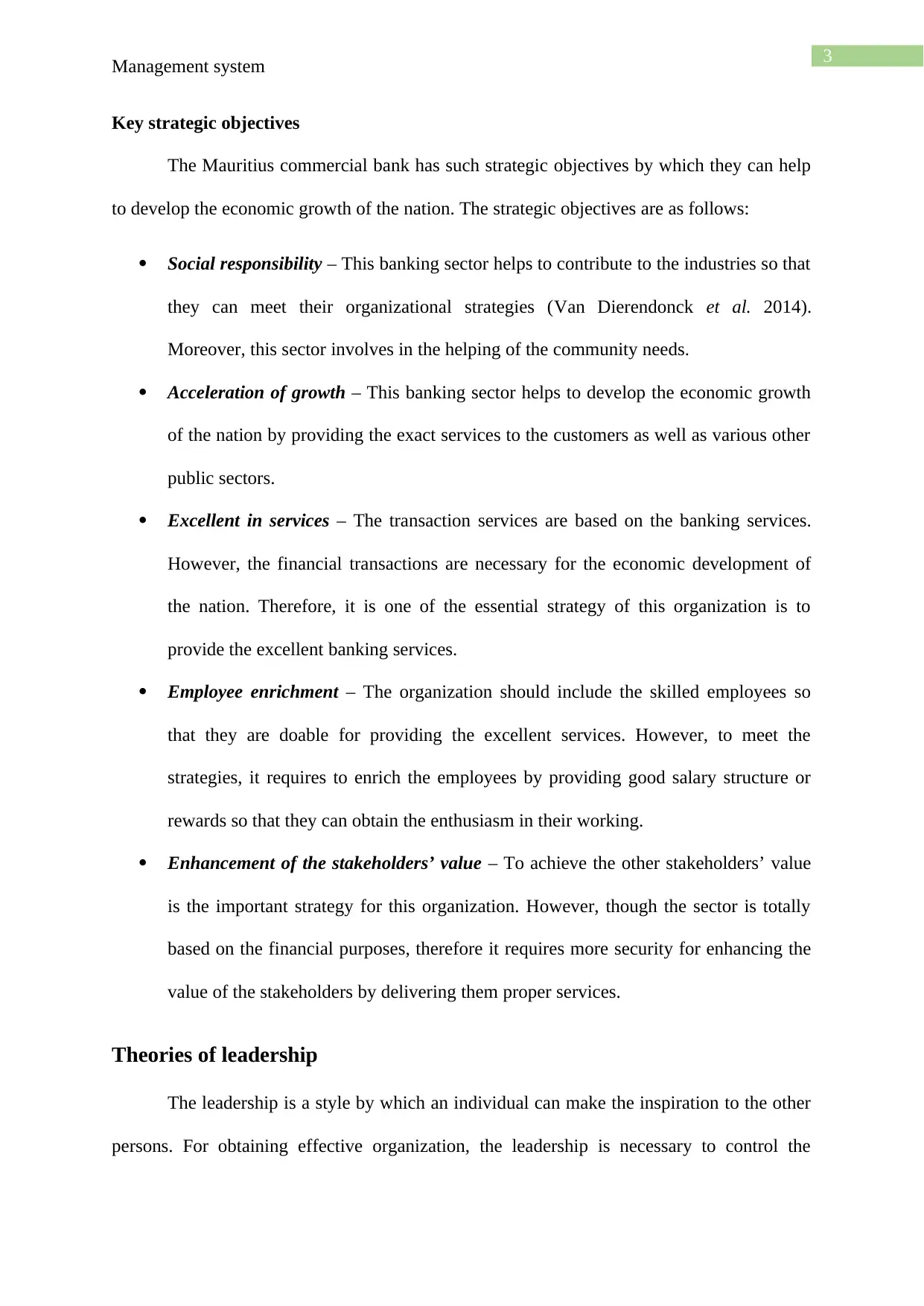
3
Management system
Key strategic objectives
The Mauritius commercial bank has such strategic objectives by which they can help
to develop the economic growth of the nation. The strategic objectives are as follows:
Social responsibility – This banking sector helps to contribute to the industries so that
they can meet their organizational strategies (Van Dierendonck et al. 2014).
Moreover, this sector involves in the helping of the community needs.
Acceleration of growth – This banking sector helps to develop the economic growth
of the nation by providing the exact services to the customers as well as various other
public sectors.
Excellent in services – The transaction services are based on the banking services.
However, the financial transactions are necessary for the economic development of
the nation. Therefore, it is one of the essential strategy of this organization is to
provide the excellent banking services.
Employee enrichment – The organization should include the skilled employees so
that they are doable for providing the excellent services. However, to meet the
strategies, it requires to enrich the employees by providing good salary structure or
rewards so that they can obtain the enthusiasm in their working.
Enhancement of the stakeholders’ value – To achieve the other stakeholders’ value
is the important strategy for this organization. However, though the sector is totally
based on the financial purposes, therefore it requires more security for enhancing the
value of the stakeholders by delivering them proper services.
Theories of leadership
The leadership is a style by which an individual can make the inspiration to the other
persons. For obtaining effective organization, the leadership is necessary to control the
Management system
Key strategic objectives
The Mauritius commercial bank has such strategic objectives by which they can help
to develop the economic growth of the nation. The strategic objectives are as follows:
Social responsibility – This banking sector helps to contribute to the industries so that
they can meet their organizational strategies (Van Dierendonck et al. 2014).
Moreover, this sector involves in the helping of the community needs.
Acceleration of growth – This banking sector helps to develop the economic growth
of the nation by providing the exact services to the customers as well as various other
public sectors.
Excellent in services – The transaction services are based on the banking services.
However, the financial transactions are necessary for the economic development of
the nation. Therefore, it is one of the essential strategy of this organization is to
provide the excellent banking services.
Employee enrichment – The organization should include the skilled employees so
that they are doable for providing the excellent services. However, to meet the
strategies, it requires to enrich the employees by providing good salary structure or
rewards so that they can obtain the enthusiasm in their working.
Enhancement of the stakeholders’ value – To achieve the other stakeholders’ value
is the important strategy for this organization. However, though the sector is totally
based on the financial purposes, therefore it requires more security for enhancing the
value of the stakeholders by delivering them proper services.
Theories of leadership
The leadership is a style by which an individual can make the inspiration to the other
persons. For obtaining effective organization, the leadership is necessary to control the
Secure Best Marks with AI Grader
Need help grading? Try our AI Grader for instant feedback on your assignments.
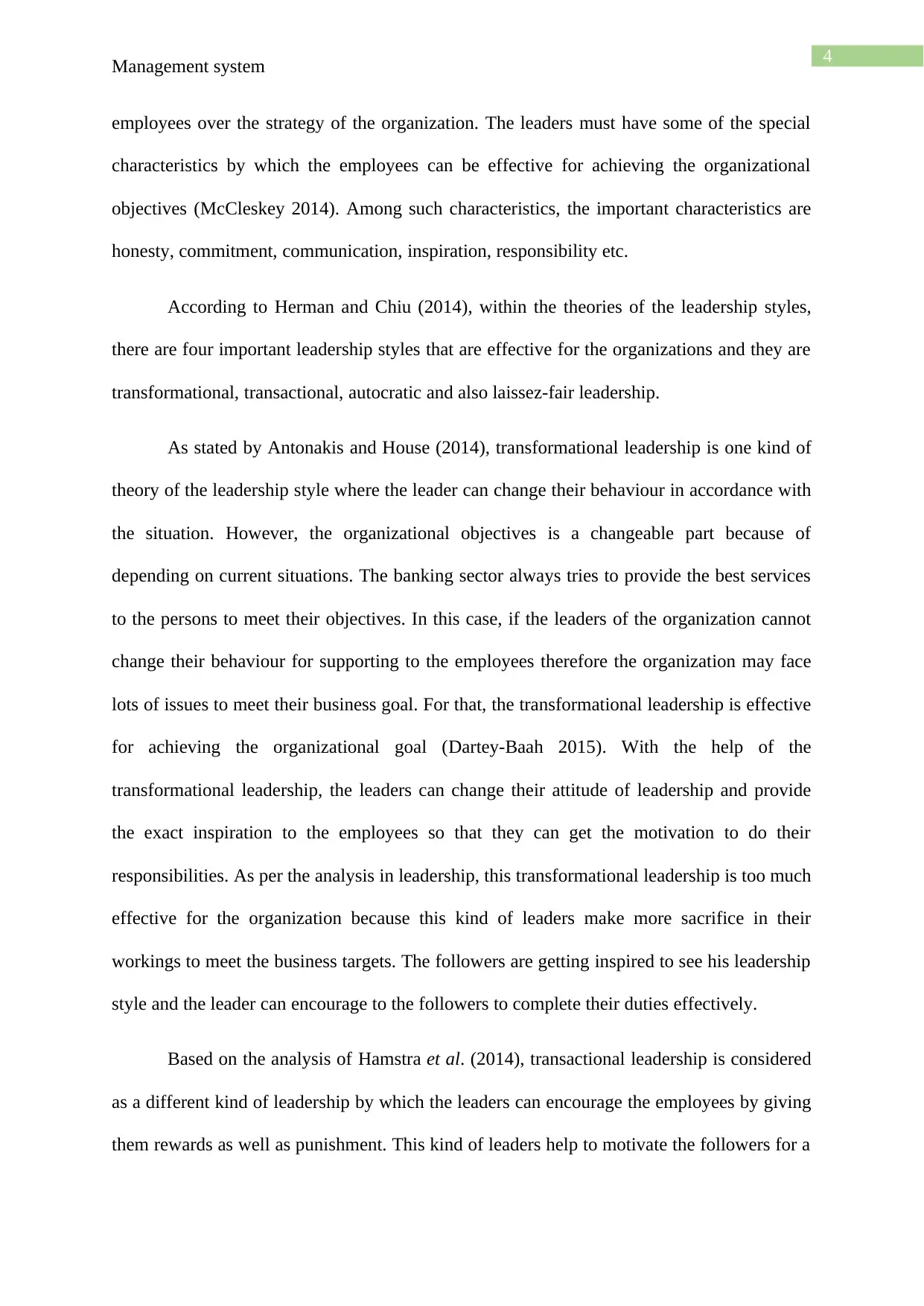
4
Management system
employees over the strategy of the organization. The leaders must have some of the special
characteristics by which the employees can be effective for achieving the organizational
objectives (McCleskey 2014). Among such characteristics, the important characteristics are
honesty, commitment, communication, inspiration, responsibility etc.
According to Herman and Chiu (2014), within the theories of the leadership styles,
there are four important leadership styles that are effective for the organizations and they are
transformational, transactional, autocratic and also laissez-fair leadership.
As stated by Antonakis and House (2014), transformational leadership is one kind of
theory of the leadership style where the leader can change their behaviour in accordance with
the situation. However, the organizational objectives is a changeable part because of
depending on current situations. The banking sector always tries to provide the best services
to the persons to meet their objectives. In this case, if the leaders of the organization cannot
change their behaviour for supporting to the employees therefore the organization may face
lots of issues to meet their business goal. For that, the transformational leadership is effective
for achieving the organizational goal (Dartey-Baah 2015). With the help of the
transformational leadership, the leaders can change their attitude of leadership and provide
the exact inspiration to the employees so that they can get the motivation to do their
responsibilities. As per the analysis in leadership, this transformational leadership is too much
effective for the organization because this kind of leaders make more sacrifice in their
workings to meet the business targets. The followers are getting inspired to see his leadership
style and the leader can encourage to the followers to complete their duties effectively.
Based on the analysis of Hamstra et al. (2014), transactional leadership is considered
as a different kind of leadership by which the leaders can encourage the employees by giving
them rewards as well as punishment. This kind of leaders help to motivate the followers for a
Management system
employees over the strategy of the organization. The leaders must have some of the special
characteristics by which the employees can be effective for achieving the organizational
objectives (McCleskey 2014). Among such characteristics, the important characteristics are
honesty, commitment, communication, inspiration, responsibility etc.
According to Herman and Chiu (2014), within the theories of the leadership styles,
there are four important leadership styles that are effective for the organizations and they are
transformational, transactional, autocratic and also laissez-fair leadership.
As stated by Antonakis and House (2014), transformational leadership is one kind of
theory of the leadership style where the leader can change their behaviour in accordance with
the situation. However, the organizational objectives is a changeable part because of
depending on current situations. The banking sector always tries to provide the best services
to the persons to meet their objectives. In this case, if the leaders of the organization cannot
change their behaviour for supporting to the employees therefore the organization may face
lots of issues to meet their business goal. For that, the transformational leadership is effective
for achieving the organizational goal (Dartey-Baah 2015). With the help of the
transformational leadership, the leaders can change their attitude of leadership and provide
the exact inspiration to the employees so that they can get the motivation to do their
responsibilities. As per the analysis in leadership, this transformational leadership is too much
effective for the organization because this kind of leaders make more sacrifice in their
workings to meet the business targets. The followers are getting inspired to see his leadership
style and the leader can encourage to the followers to complete their duties effectively.
Based on the analysis of Hamstra et al. (2014), transactional leadership is considered
as a different kind of leadership by which the leaders can encourage the employees by giving
them rewards as well as punishment. This kind of leaders help to motivate the followers for a
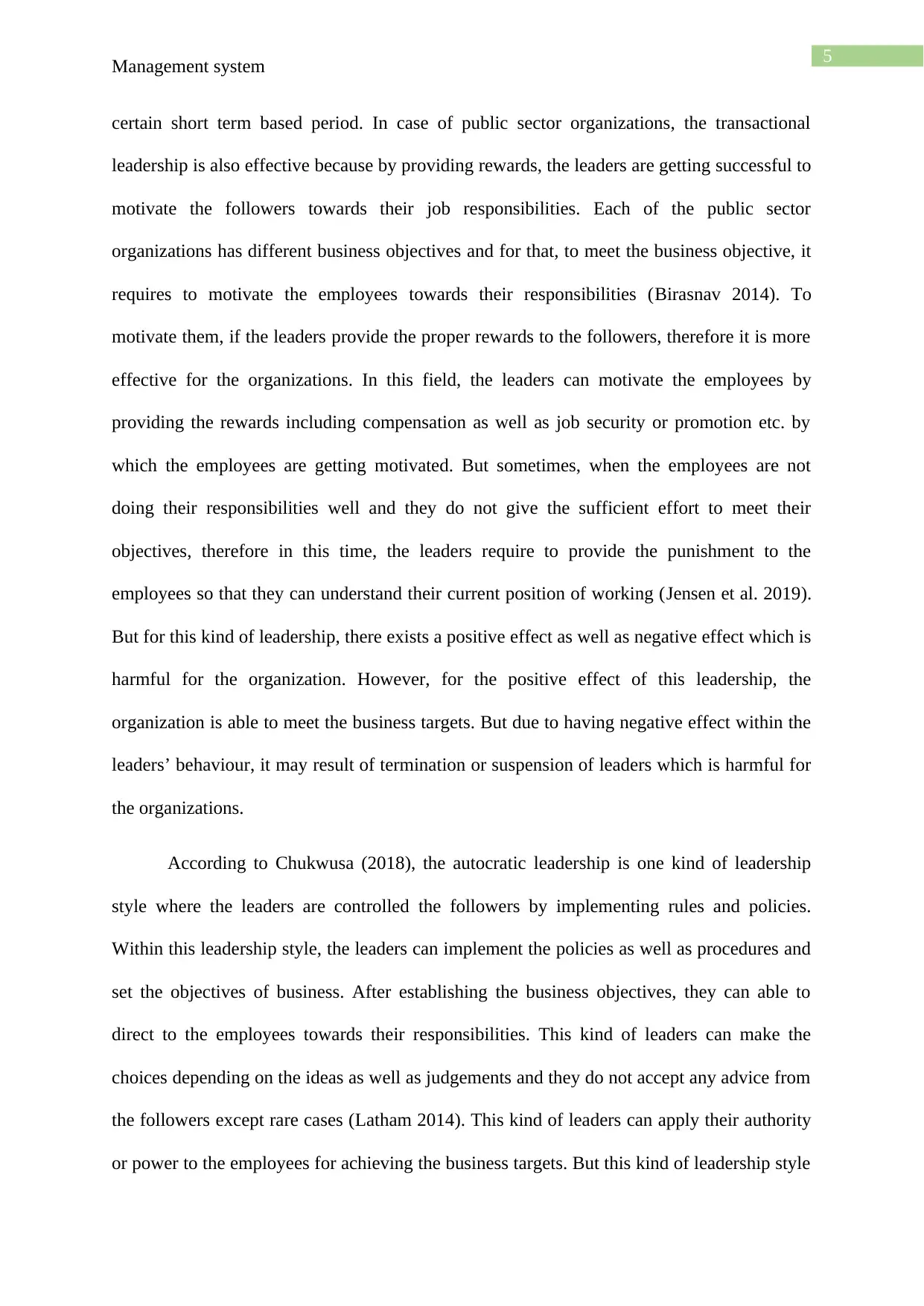
5
Management system
certain short term based period. In case of public sector organizations, the transactional
leadership is also effective because by providing rewards, the leaders are getting successful to
motivate the followers towards their job responsibilities. Each of the public sector
organizations has different business objectives and for that, to meet the business objective, it
requires to motivate the employees towards their responsibilities (Birasnav 2014). To
motivate them, if the leaders provide the proper rewards to the followers, therefore it is more
effective for the organizations. In this field, the leaders can motivate the employees by
providing the rewards including compensation as well as job security or promotion etc. by
which the employees are getting motivated. But sometimes, when the employees are not
doing their responsibilities well and they do not give the sufficient effort to meet their
objectives, therefore in this time, the leaders require to provide the punishment to the
employees so that they can understand their current position of working (Jensen et al. 2019).
But for this kind of leadership, there exists a positive effect as well as negative effect which is
harmful for the organization. However, for the positive effect of this leadership, the
organization is able to meet the business targets. But due to having negative effect within the
leaders’ behaviour, it may result of termination or suspension of leaders which is harmful for
the organizations.
According to Chukwusa (2018), the autocratic leadership is one kind of leadership
style where the leaders are controlled the followers by implementing rules and policies.
Within this leadership style, the leaders can implement the policies as well as procedures and
set the objectives of business. After establishing the business objectives, they can able to
direct to the employees towards their responsibilities. This kind of leaders can make the
choices depending on the ideas as well as judgements and they do not accept any advice from
the followers except rare cases (Latham 2014). This kind of leaders can apply their authority
or power to the employees for achieving the business targets. But this kind of leadership style
Management system
certain short term based period. In case of public sector organizations, the transactional
leadership is also effective because by providing rewards, the leaders are getting successful to
motivate the followers towards their job responsibilities. Each of the public sector
organizations has different business objectives and for that, to meet the business objective, it
requires to motivate the employees towards their responsibilities (Birasnav 2014). To
motivate them, if the leaders provide the proper rewards to the followers, therefore it is more
effective for the organizations. In this field, the leaders can motivate the employees by
providing the rewards including compensation as well as job security or promotion etc. by
which the employees are getting motivated. But sometimes, when the employees are not
doing their responsibilities well and they do not give the sufficient effort to meet their
objectives, therefore in this time, the leaders require to provide the punishment to the
employees so that they can understand their current position of working (Jensen et al. 2019).
But for this kind of leadership, there exists a positive effect as well as negative effect which is
harmful for the organization. However, for the positive effect of this leadership, the
organization is able to meet the business targets. But due to having negative effect within the
leaders’ behaviour, it may result of termination or suspension of leaders which is harmful for
the organizations.
According to Chukwusa (2018), the autocratic leadership is one kind of leadership
style where the leaders are controlled the followers by implementing rules and policies.
Within this leadership style, the leaders can implement the policies as well as procedures and
set the objectives of business. After establishing the business objectives, they can able to
direct to the employees towards their responsibilities. This kind of leaders can make the
choices depending on the ideas as well as judgements and they do not accept any advice from
the followers except rare cases (Latham 2014). This kind of leaders can apply their authority
or power to the employees for achieving the business targets. But this kind of leadership style
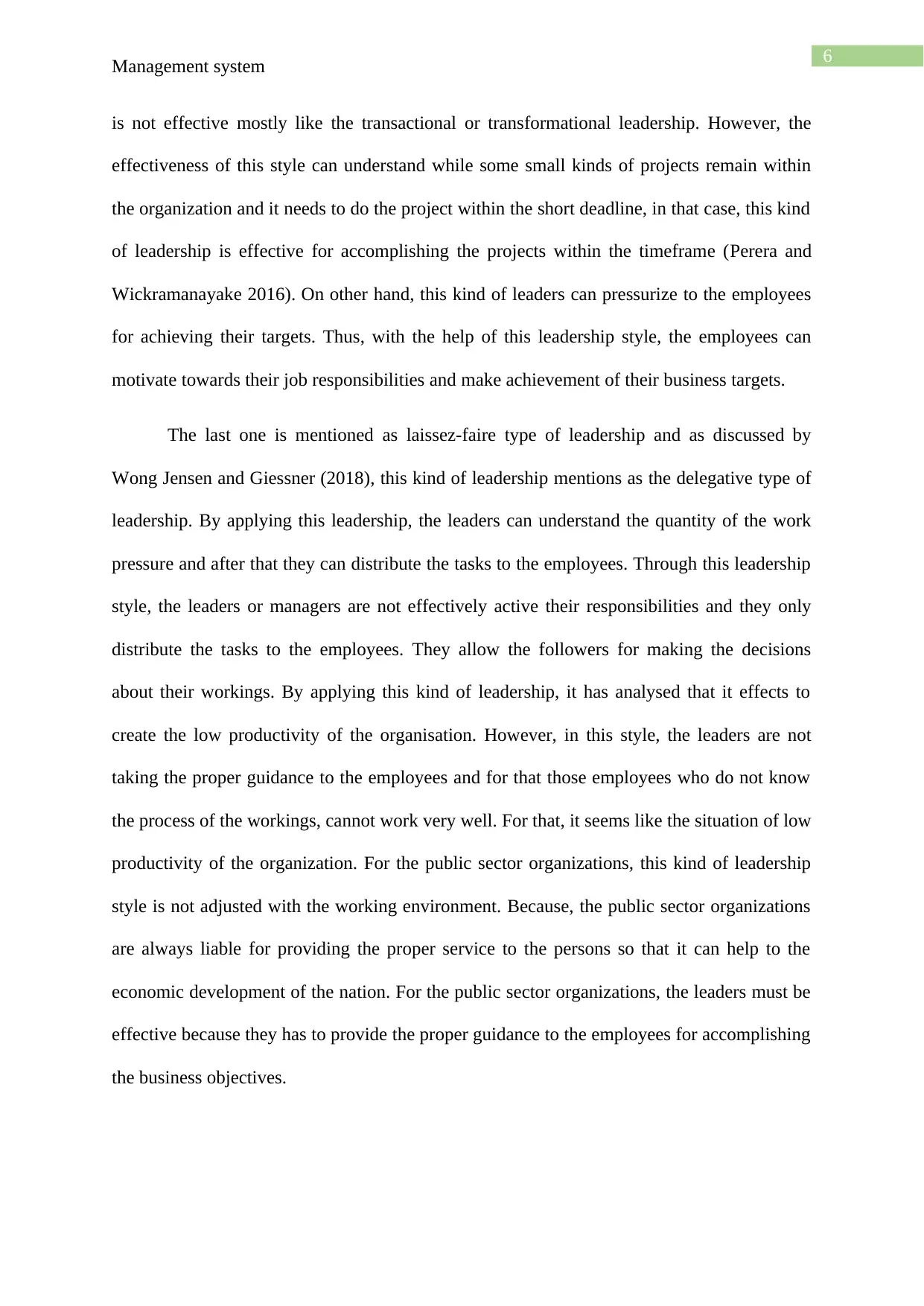
6
Management system
is not effective mostly like the transactional or transformational leadership. However, the
effectiveness of this style can understand while some small kinds of projects remain within
the organization and it needs to do the project within the short deadline, in that case, this kind
of leadership is effective for accomplishing the projects within the timeframe (Perera and
Wickramanayake 2016). On other hand, this kind of leaders can pressurize to the employees
for achieving their targets. Thus, with the help of this leadership style, the employees can
motivate towards their job responsibilities and make achievement of their business targets.
The last one is mentioned as laissez-faire type of leadership and as discussed by
Wong Jensen and Giessner (2018), this kind of leadership mentions as the delegative type of
leadership. By applying this leadership, the leaders can understand the quantity of the work
pressure and after that they can distribute the tasks to the employees. Through this leadership
style, the leaders or managers are not effectively active their responsibilities and they only
distribute the tasks to the employees. They allow the followers for making the decisions
about their workings. By applying this kind of leadership, it has analysed that it effects to
create the low productivity of the organisation. However, in this style, the leaders are not
taking the proper guidance to the employees and for that those employees who do not know
the process of the workings, cannot work very well. For that, it seems like the situation of low
productivity of the organization. For the public sector organizations, this kind of leadership
style is not adjusted with the working environment. Because, the public sector organizations
are always liable for providing the proper service to the persons so that it can help to the
economic development of the nation. For the public sector organizations, the leaders must be
effective because they has to provide the proper guidance to the employees for accomplishing
the business objectives.
Management system
is not effective mostly like the transactional or transformational leadership. However, the
effectiveness of this style can understand while some small kinds of projects remain within
the organization and it needs to do the project within the short deadline, in that case, this kind
of leadership is effective for accomplishing the projects within the timeframe (Perera and
Wickramanayake 2016). On other hand, this kind of leaders can pressurize to the employees
for achieving their targets. Thus, with the help of this leadership style, the employees can
motivate towards their job responsibilities and make achievement of their business targets.
The last one is mentioned as laissez-faire type of leadership and as discussed by
Wong Jensen and Giessner (2018), this kind of leadership mentions as the delegative type of
leadership. By applying this leadership, the leaders can understand the quantity of the work
pressure and after that they can distribute the tasks to the employees. Through this leadership
style, the leaders or managers are not effectively active their responsibilities and they only
distribute the tasks to the employees. They allow the followers for making the decisions
about their workings. By applying this kind of leadership, it has analysed that it effects to
create the low productivity of the organisation. However, in this style, the leaders are not
taking the proper guidance to the employees and for that those employees who do not know
the process of the workings, cannot work very well. For that, it seems like the situation of low
productivity of the organization. For the public sector organizations, this kind of leadership
style is not adjusted with the working environment. Because, the public sector organizations
are always liable for providing the proper service to the persons so that it can help to the
economic development of the nation. For the public sector organizations, the leaders must be
effective because they has to provide the proper guidance to the employees for accomplishing
the business objectives.
Paraphrase This Document
Need a fresh take? Get an instant paraphrase of this document with our AI Paraphraser
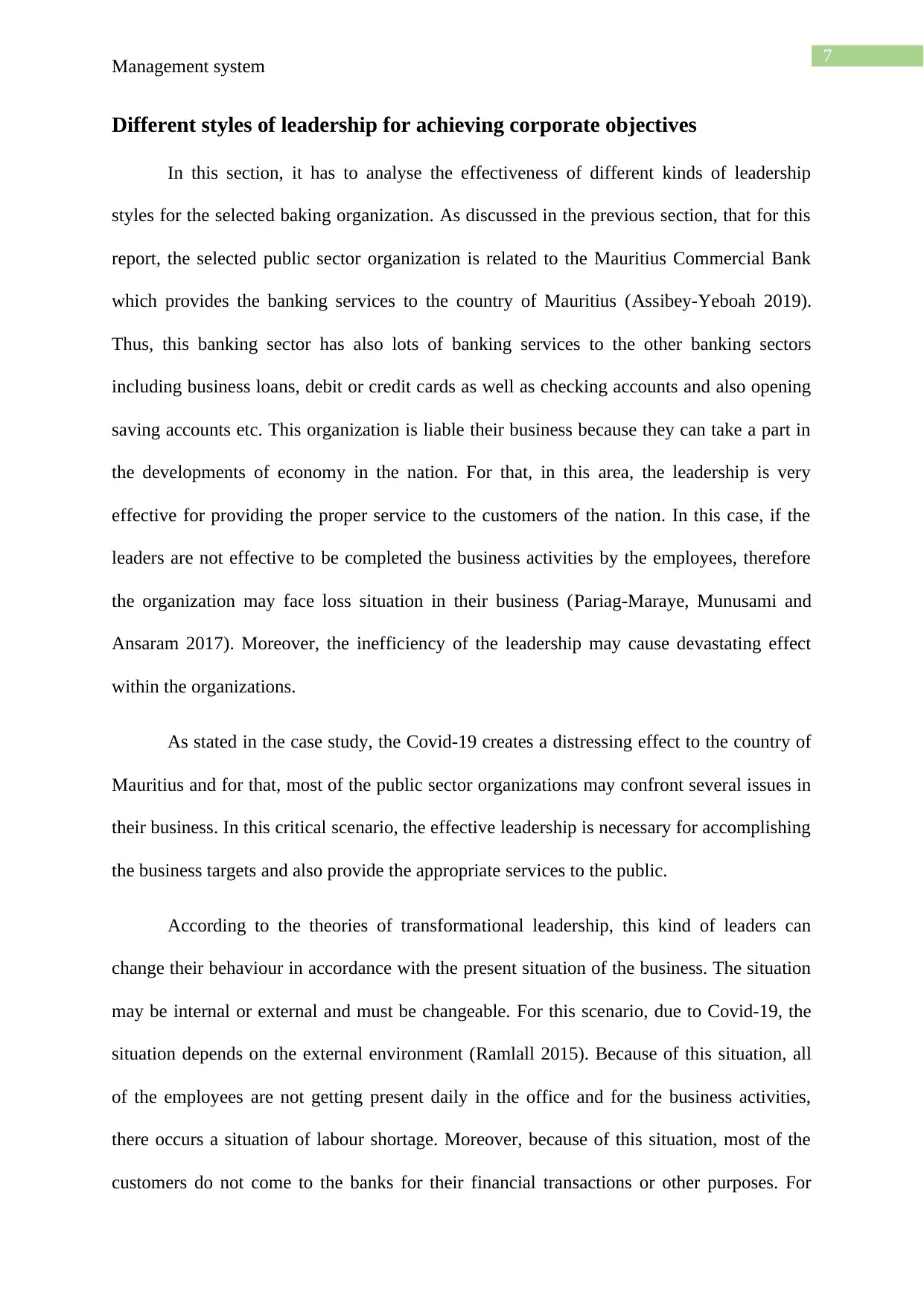
7
Management system
Different styles of leadership for achieving corporate objectives
In this section, it has to analyse the effectiveness of different kinds of leadership
styles for the selected baking organization. As discussed in the previous section, that for this
report, the selected public sector organization is related to the Mauritius Commercial Bank
which provides the banking services to the country of Mauritius (Assibey-Yeboah 2019).
Thus, this banking sector has also lots of banking services to the other banking sectors
including business loans, debit or credit cards as well as checking accounts and also opening
saving accounts etc. This organization is liable their business because they can take a part in
the developments of economy in the nation. For that, in this area, the leadership is very
effective for providing the proper service to the customers of the nation. In this case, if the
leaders are not effective to be completed the business activities by the employees, therefore
the organization may face loss situation in their business (Pariag-Maraye, Munusami and
Ansaram 2017). Moreover, the inefficiency of the leadership may cause devastating effect
within the organizations.
As stated in the case study, the Covid-19 creates a distressing effect to the country of
Mauritius and for that, most of the public sector organizations may confront several issues in
their business. In this critical scenario, the effective leadership is necessary for accomplishing
the business targets and also provide the appropriate services to the public.
According to the theories of transformational leadership, this kind of leaders can
change their behaviour in accordance with the present situation of the business. The situation
may be internal or external and must be changeable. For this scenario, due to Covid-19, the
situation depends on the external environment (Ramlall 2015). Because of this situation, all
of the employees are not getting present daily in the office and for the business activities,
there occurs a situation of labour shortage. Moreover, because of this situation, most of the
customers do not come to the banks for their financial transactions or other purposes. For
Management system
Different styles of leadership for achieving corporate objectives
In this section, it has to analyse the effectiveness of different kinds of leadership
styles for the selected baking organization. As discussed in the previous section, that for this
report, the selected public sector organization is related to the Mauritius Commercial Bank
which provides the banking services to the country of Mauritius (Assibey-Yeboah 2019).
Thus, this banking sector has also lots of banking services to the other banking sectors
including business loans, debit or credit cards as well as checking accounts and also opening
saving accounts etc. This organization is liable their business because they can take a part in
the developments of economy in the nation. For that, in this area, the leadership is very
effective for providing the proper service to the customers of the nation. In this case, if the
leaders are not effective to be completed the business activities by the employees, therefore
the organization may face loss situation in their business (Pariag-Maraye, Munusami and
Ansaram 2017). Moreover, the inefficiency of the leadership may cause devastating effect
within the organizations.
As stated in the case study, the Covid-19 creates a distressing effect to the country of
Mauritius and for that, most of the public sector organizations may confront several issues in
their business. In this critical scenario, the effective leadership is necessary for accomplishing
the business targets and also provide the appropriate services to the public.
According to the theories of transformational leadership, this kind of leaders can
change their behaviour in accordance with the present situation of the business. The situation
may be internal or external and must be changeable. For this scenario, due to Covid-19, the
situation depends on the external environment (Ramlall 2015). Because of this situation, all
of the employees are not getting present daily in the office and for the business activities,
there occurs a situation of labour shortage. Moreover, because of this situation, most of the
customers do not come to the banks for their financial transactions or other purposes. For
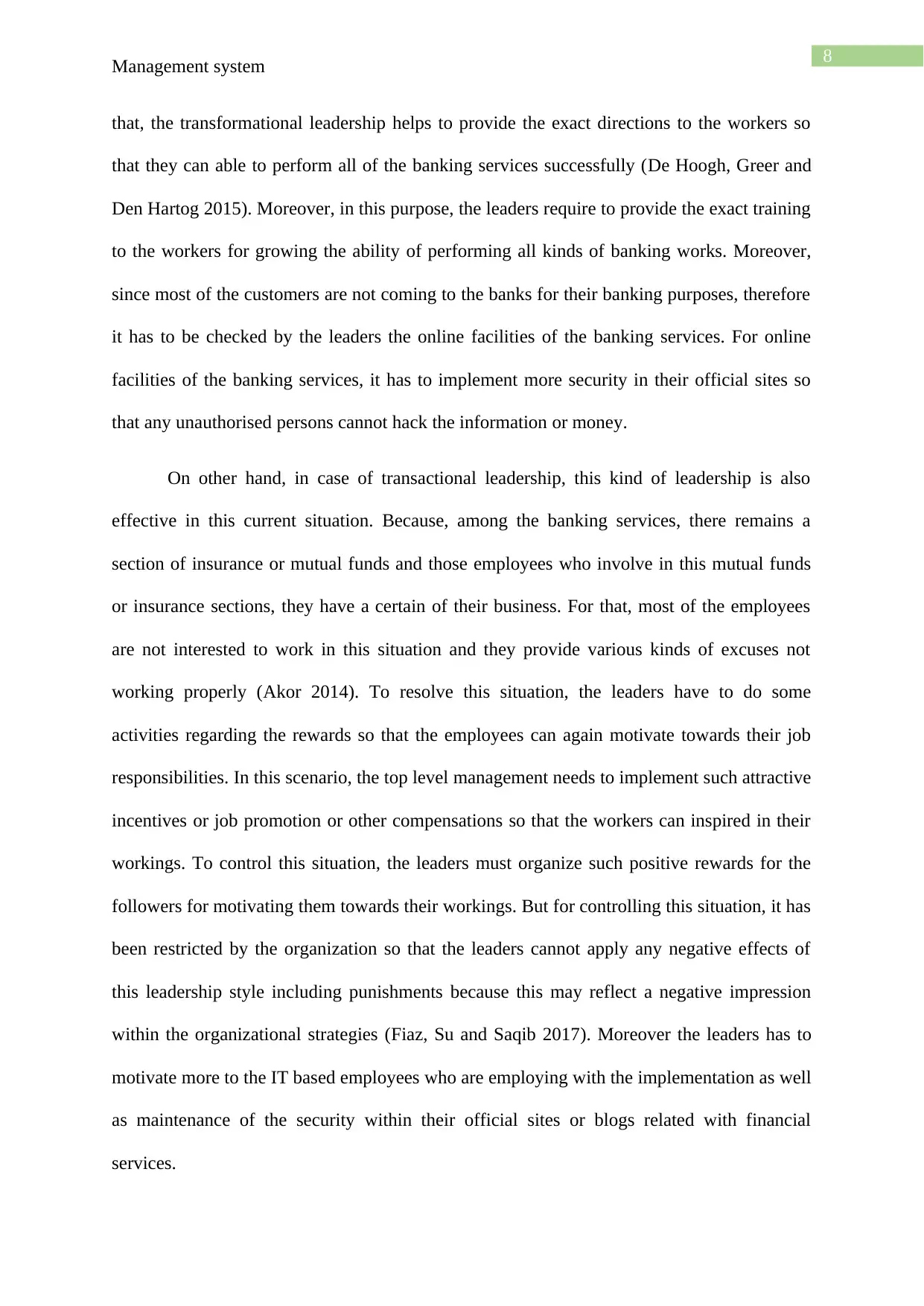
8
Management system
that, the transformational leadership helps to provide the exact directions to the workers so
that they can able to perform all of the banking services successfully (De Hoogh, Greer and
Den Hartog 2015). Moreover, in this purpose, the leaders require to provide the exact training
to the workers for growing the ability of performing all kinds of banking works. Moreover,
since most of the customers are not coming to the banks for their banking purposes, therefore
it has to be checked by the leaders the online facilities of the banking services. For online
facilities of the banking services, it has to implement more security in their official sites so
that any unauthorised persons cannot hack the information or money.
On other hand, in case of transactional leadership, this kind of leadership is also
effective in this current situation. Because, among the banking services, there remains a
section of insurance or mutual funds and those employees who involve in this mutual funds
or insurance sections, they have a certain of their business. For that, most of the employees
are not interested to work in this situation and they provide various kinds of excuses not
working properly (Akor 2014). To resolve this situation, the leaders have to do some
activities regarding the rewards so that the employees can again motivate towards their job
responsibilities. In this scenario, the top level management needs to implement such attractive
incentives or job promotion or other compensations so that the workers can inspired in their
workings. To control this situation, the leaders must organize such positive rewards for the
followers for motivating them towards their workings. But for controlling this situation, it has
been restricted by the organization so that the leaders cannot apply any negative effects of
this leadership style including punishments because this may reflect a negative impression
within the organizational strategies (Fiaz, Su and Saqib 2017). Moreover the leaders has to
motivate more to the IT based employees who are employing with the implementation as well
as maintenance of the security within their official sites or blogs related with financial
services.
Management system
that, the transformational leadership helps to provide the exact directions to the workers so
that they can able to perform all of the banking services successfully (De Hoogh, Greer and
Den Hartog 2015). Moreover, in this purpose, the leaders require to provide the exact training
to the workers for growing the ability of performing all kinds of banking works. Moreover,
since most of the customers are not coming to the banks for their banking purposes, therefore
it has to be checked by the leaders the online facilities of the banking services. For online
facilities of the banking services, it has to implement more security in their official sites so
that any unauthorised persons cannot hack the information or money.
On other hand, in case of transactional leadership, this kind of leadership is also
effective in this current situation. Because, among the banking services, there remains a
section of insurance or mutual funds and those employees who involve in this mutual funds
or insurance sections, they have a certain of their business. For that, most of the employees
are not interested to work in this situation and they provide various kinds of excuses not
working properly (Akor 2014). To resolve this situation, the leaders have to do some
activities regarding the rewards so that the employees can again motivate towards their job
responsibilities. In this scenario, the top level management needs to implement such attractive
incentives or job promotion or other compensations so that the workers can inspired in their
workings. To control this situation, the leaders must organize such positive rewards for the
followers for motivating them towards their workings. But for controlling this situation, it has
been restricted by the organization so that the leaders cannot apply any negative effects of
this leadership style including punishments because this may reflect a negative impression
within the organizational strategies (Fiaz, Su and Saqib 2017). Moreover the leaders has to
motivate more to the IT based employees who are employing with the implementation as well
as maintenance of the security within their official sites or blogs related with financial
services.
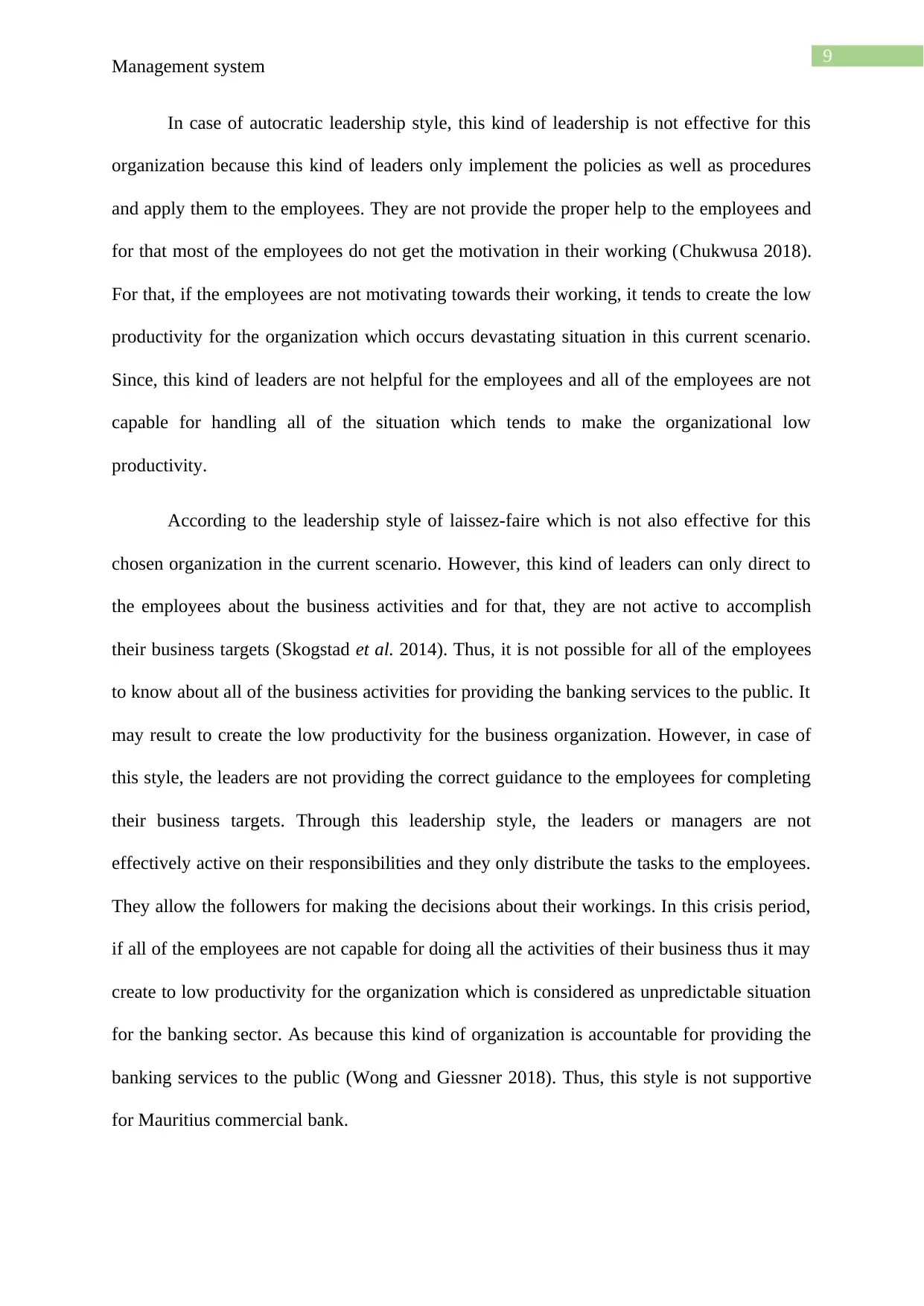
9
Management system
In case of autocratic leadership style, this kind of leadership is not effective for this
organization because this kind of leaders only implement the policies as well as procedures
and apply them to the employees. They are not provide the proper help to the employees and
for that most of the employees do not get the motivation in their working (Chukwusa 2018).
For that, if the employees are not motivating towards their working, it tends to create the low
productivity for the organization which occurs devastating situation in this current scenario.
Since, this kind of leaders are not helpful for the employees and all of the employees are not
capable for handling all of the situation which tends to make the organizational low
productivity.
According to the leadership style of laissez-faire which is not also effective for this
chosen organization in the current scenario. However, this kind of leaders can only direct to
the employees about the business activities and for that, they are not active to accomplish
their business targets (Skogstad et al. 2014). Thus, it is not possible for all of the employees
to know about all of the business activities for providing the banking services to the public. It
may result to create the low productivity for the business organization. However, in case of
this style, the leaders are not providing the correct guidance to the employees for completing
their business targets. Through this leadership style, the leaders or managers are not
effectively active on their responsibilities and they only distribute the tasks to the employees.
They allow the followers for making the decisions about their workings. In this crisis period,
if all of the employees are not capable for doing all the activities of their business thus it may
create to low productivity for the organization which is considered as unpredictable situation
for the banking sector. As because this kind of organization is accountable for providing the
banking services to the public (Wong and Giessner 2018). Thus, this style is not supportive
for Mauritius commercial bank.
Management system
In case of autocratic leadership style, this kind of leadership is not effective for this
organization because this kind of leaders only implement the policies as well as procedures
and apply them to the employees. They are not provide the proper help to the employees and
for that most of the employees do not get the motivation in their working (Chukwusa 2018).
For that, if the employees are not motivating towards their working, it tends to create the low
productivity for the organization which occurs devastating situation in this current scenario.
Since, this kind of leaders are not helpful for the employees and all of the employees are not
capable for handling all of the situation which tends to make the organizational low
productivity.
According to the leadership style of laissez-faire which is not also effective for this
chosen organization in the current scenario. However, this kind of leaders can only direct to
the employees about the business activities and for that, they are not active to accomplish
their business targets (Skogstad et al. 2014). Thus, it is not possible for all of the employees
to know about all of the business activities for providing the banking services to the public. It
may result to create the low productivity for the business organization. However, in case of
this style, the leaders are not providing the correct guidance to the employees for completing
their business targets. Through this leadership style, the leaders or managers are not
effectively active on their responsibilities and they only distribute the tasks to the employees.
They allow the followers for making the decisions about their workings. In this crisis period,
if all of the employees are not capable for doing all the activities of their business thus it may
create to low productivity for the organization which is considered as unpredictable situation
for the banking sector. As because this kind of organization is accountable for providing the
banking services to the public (Wong and Giessner 2018). Thus, this style is not supportive
for Mauritius commercial bank.
Secure Best Marks with AI Grader
Need help grading? Try our AI Grader for instant feedback on your assignments.
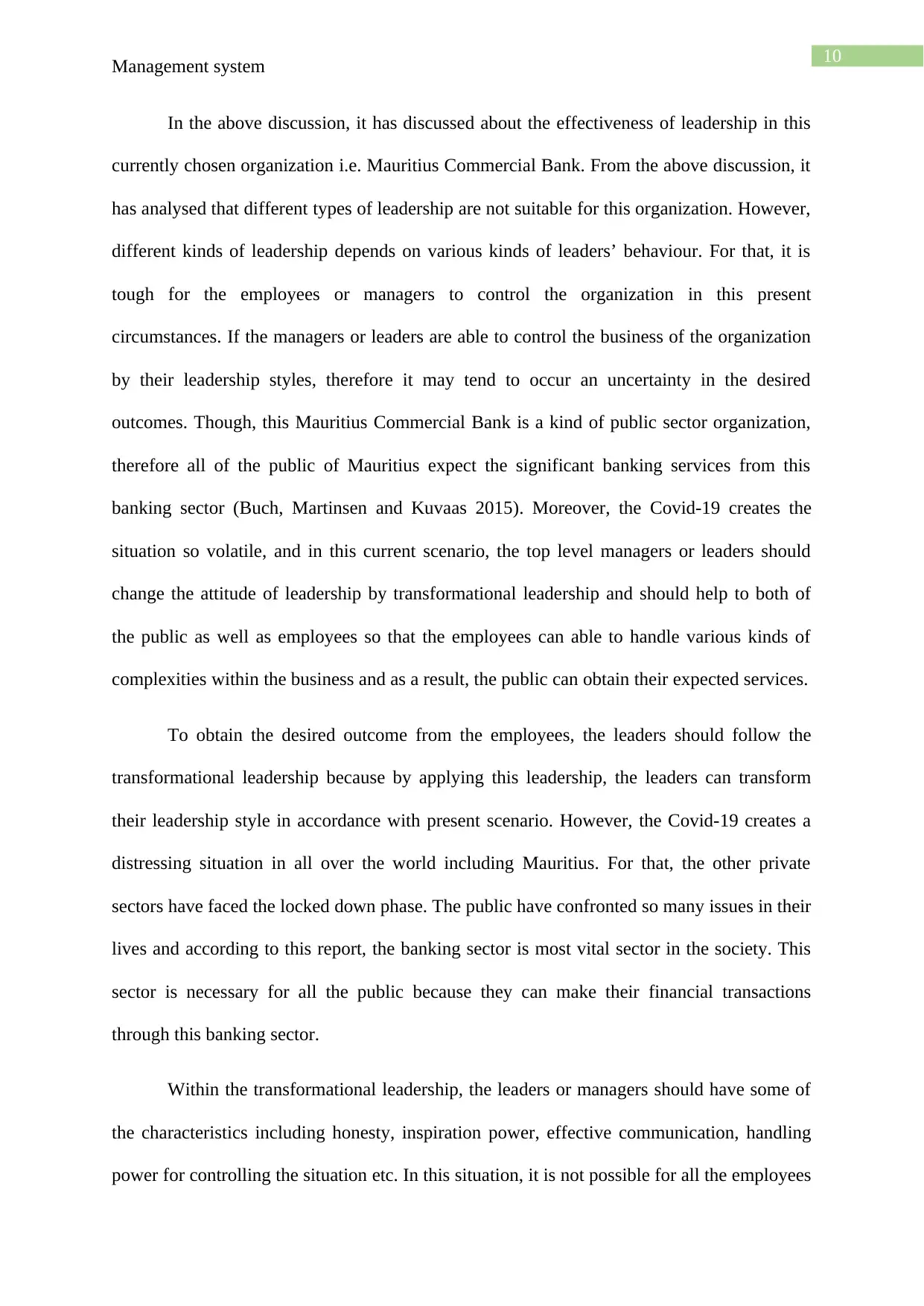
10
Management system
In the above discussion, it has discussed about the effectiveness of leadership in this
currently chosen organization i.e. Mauritius Commercial Bank. From the above discussion, it
has analysed that different types of leadership are not suitable for this organization. However,
different kinds of leadership depends on various kinds of leaders’ behaviour. For that, it is
tough for the employees or managers to control the organization in this present
circumstances. If the managers or leaders are able to control the business of the organization
by their leadership styles, therefore it may tend to occur an uncertainty in the desired
outcomes. Though, this Mauritius Commercial Bank is a kind of public sector organization,
therefore all of the public of Mauritius expect the significant banking services from this
banking sector (Buch, Martinsen and Kuvaas 2015). Moreover, the Covid-19 creates the
situation so volatile, and in this current scenario, the top level managers or leaders should
change the attitude of leadership by transformational leadership and should help to both of
the public as well as employees so that the employees can able to handle various kinds of
complexities within the business and as a result, the public can obtain their expected services.
To obtain the desired outcome from the employees, the leaders should follow the
transformational leadership because by applying this leadership, the leaders can transform
their leadership style in accordance with present scenario. However, the Covid-19 creates a
distressing situation in all over the world including Mauritius. For that, the other private
sectors have faced the locked down phase. The public have confronted so many issues in their
lives and according to this report, the banking sector is most vital sector in the society. This
sector is necessary for all the public because they can make their financial transactions
through this banking sector.
Within the transformational leadership, the leaders or managers should have some of
the characteristics including honesty, inspiration power, effective communication, handling
power for controlling the situation etc. In this situation, it is not possible for all the employees
Management system
In the above discussion, it has discussed about the effectiveness of leadership in this
currently chosen organization i.e. Mauritius Commercial Bank. From the above discussion, it
has analysed that different types of leadership are not suitable for this organization. However,
different kinds of leadership depends on various kinds of leaders’ behaviour. For that, it is
tough for the employees or managers to control the organization in this present
circumstances. If the managers or leaders are able to control the business of the organization
by their leadership styles, therefore it may tend to occur an uncertainty in the desired
outcomes. Though, this Mauritius Commercial Bank is a kind of public sector organization,
therefore all of the public of Mauritius expect the significant banking services from this
banking sector (Buch, Martinsen and Kuvaas 2015). Moreover, the Covid-19 creates the
situation so volatile, and in this current scenario, the top level managers or leaders should
change the attitude of leadership by transformational leadership and should help to both of
the public as well as employees so that the employees can able to handle various kinds of
complexities within the business and as a result, the public can obtain their expected services.
To obtain the desired outcome from the employees, the leaders should follow the
transformational leadership because by applying this leadership, the leaders can transform
their leadership style in accordance with present scenario. However, the Covid-19 creates a
distressing situation in all over the world including Mauritius. For that, the other private
sectors have faced the locked down phase. The public have confronted so many issues in their
lives and according to this report, the banking sector is most vital sector in the society. This
sector is necessary for all the public because they can make their financial transactions
through this banking sector.
Within the transformational leadership, the leaders or managers should have some of
the characteristics including honesty, inspiration power, effective communication, handling
power for controlling the situation etc. In this situation, it is not possible for all the employees
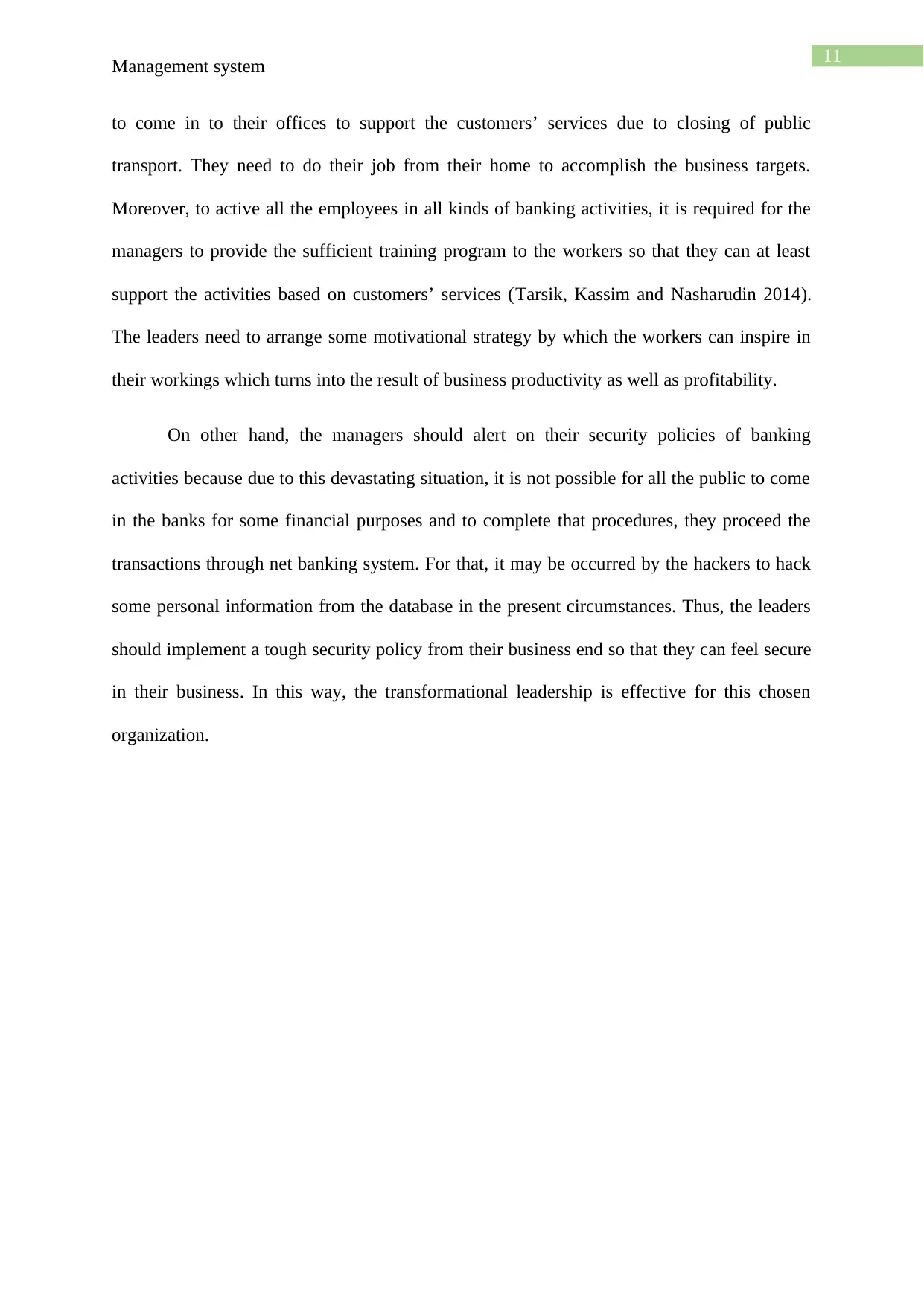
11
Management system
to come in to their offices to support the customers’ services due to closing of public
transport. They need to do their job from their home to accomplish the business targets.
Moreover, to active all the employees in all kinds of banking activities, it is required for the
managers to provide the sufficient training program to the workers so that they can at least
support the activities based on customers’ services (Tarsik, Kassim and Nasharudin 2014).
The leaders need to arrange some motivational strategy by which the workers can inspire in
their workings which turns into the result of business productivity as well as profitability.
On other hand, the managers should alert on their security policies of banking
activities because due to this devastating situation, it is not possible for all the public to come
in the banks for some financial purposes and to complete that procedures, they proceed the
transactions through net banking system. For that, it may be occurred by the hackers to hack
some personal information from the database in the present circumstances. Thus, the leaders
should implement a tough security policy from their business end so that they can feel secure
in their business. In this way, the transformational leadership is effective for this chosen
organization.
Management system
to come in to their offices to support the customers’ services due to closing of public
transport. They need to do their job from their home to accomplish the business targets.
Moreover, to active all the employees in all kinds of banking activities, it is required for the
managers to provide the sufficient training program to the workers so that they can at least
support the activities based on customers’ services (Tarsik, Kassim and Nasharudin 2014).
The leaders need to arrange some motivational strategy by which the workers can inspire in
their workings which turns into the result of business productivity as well as profitability.
On other hand, the managers should alert on their security policies of banking
activities because due to this devastating situation, it is not possible for all the public to come
in the banks for some financial purposes and to complete that procedures, they proceed the
transactions through net banking system. For that, it may be occurred by the hackers to hack
some personal information from the database in the present circumstances. Thus, the leaders
should implement a tough security policy from their business end so that they can feel secure
in their business. In this way, the transformational leadership is effective for this chosen
organization.
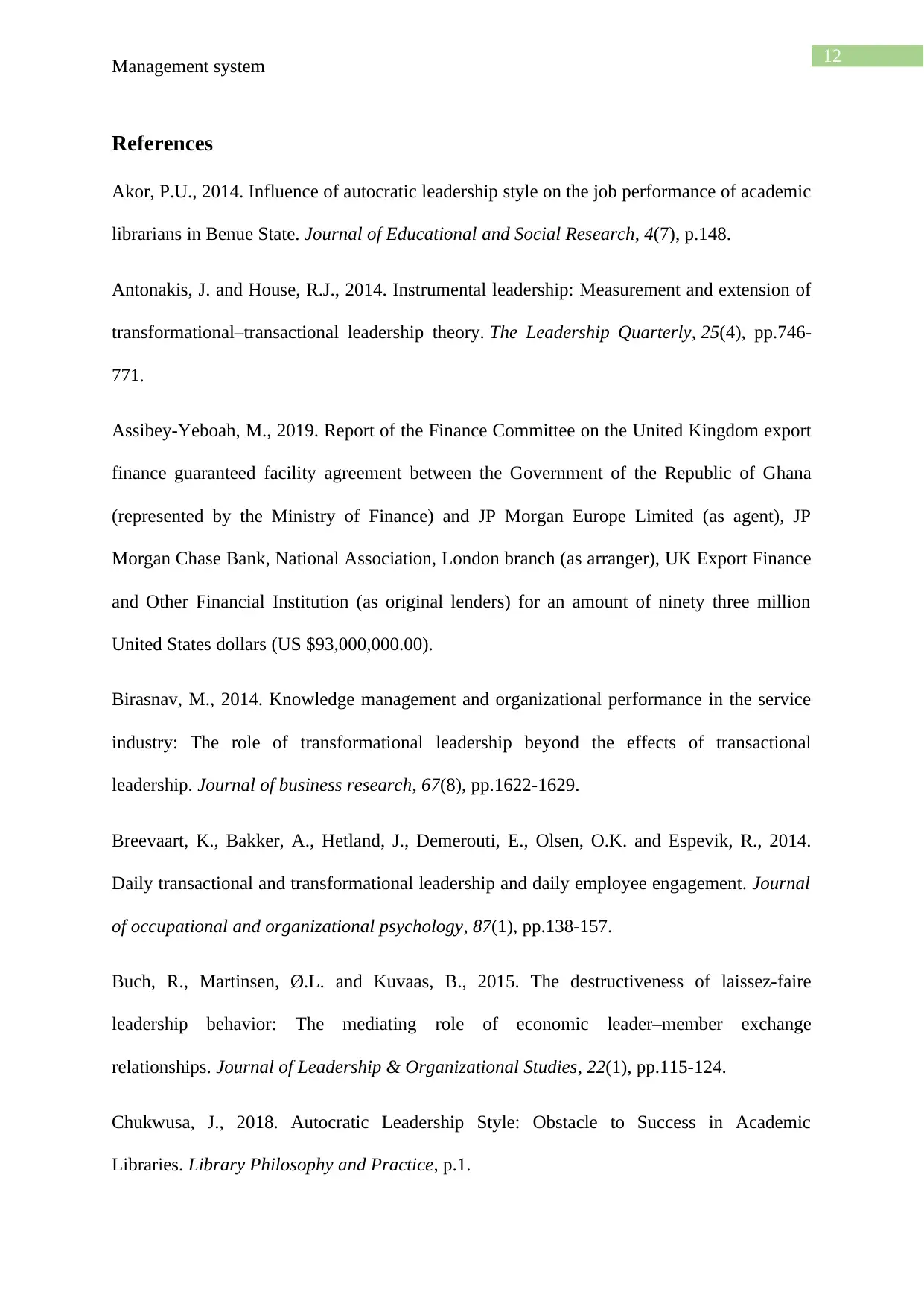
12
Management system
References
Akor, P.U., 2014. Influence of autocratic leadership style on the job performance of academic
librarians in Benue State. Journal of Educational and Social Research, 4(7), p.148.
Antonakis, J. and House, R.J., 2014. Instrumental leadership: Measurement and extension of
transformational–transactional leadership theory. The Leadership Quarterly, 25(4), pp.746-
771.
Assibey-Yeboah, M., 2019. Report of the Finance Committee on the United Kingdom export
finance guaranteed facility agreement between the Government of the Republic of Ghana
(represented by the Ministry of Finance) and JP Morgan Europe Limited (as agent), JP
Morgan Chase Bank, National Association, London branch (as arranger), UK Export Finance
and Other Financial Institution (as original lenders) for an amount of ninety three million
United States dollars (US $93,000,000.00).
Birasnav, M., 2014. Knowledge management and organizational performance in the service
industry: The role of transformational leadership beyond the effects of transactional
leadership. Journal of business research, 67(8), pp.1622-1629.
Breevaart, K., Bakker, A., Hetland, J., Demerouti, E., Olsen, O.K. and Espevik, R., 2014.
Daily transactional and transformational leadership and daily employee engagement. Journal
of occupational and organizational psychology, 87(1), pp.138-157.
Buch, R., Martinsen, Ø.L. and Kuvaas, B., 2015. The destructiveness of laissez-faire
leadership behavior: The mediating role of economic leader–member exchange
relationships. Journal of Leadership & Organizational Studies, 22(1), pp.115-124.
Chukwusa, J., 2018. Autocratic Leadership Style: Obstacle to Success in Academic
Libraries. Library Philosophy and Practice, p.1.
Management system
References
Akor, P.U., 2014. Influence of autocratic leadership style on the job performance of academic
librarians in Benue State. Journal of Educational and Social Research, 4(7), p.148.
Antonakis, J. and House, R.J., 2014. Instrumental leadership: Measurement and extension of
transformational–transactional leadership theory. The Leadership Quarterly, 25(4), pp.746-
771.
Assibey-Yeboah, M., 2019. Report of the Finance Committee on the United Kingdom export
finance guaranteed facility agreement between the Government of the Republic of Ghana
(represented by the Ministry of Finance) and JP Morgan Europe Limited (as agent), JP
Morgan Chase Bank, National Association, London branch (as arranger), UK Export Finance
and Other Financial Institution (as original lenders) for an amount of ninety three million
United States dollars (US $93,000,000.00).
Birasnav, M., 2014. Knowledge management and organizational performance in the service
industry: The role of transformational leadership beyond the effects of transactional
leadership. Journal of business research, 67(8), pp.1622-1629.
Breevaart, K., Bakker, A., Hetland, J., Demerouti, E., Olsen, O.K. and Espevik, R., 2014.
Daily transactional and transformational leadership and daily employee engagement. Journal
of occupational and organizational psychology, 87(1), pp.138-157.
Buch, R., Martinsen, Ø.L. and Kuvaas, B., 2015. The destructiveness of laissez-faire
leadership behavior: The mediating role of economic leader–member exchange
relationships. Journal of Leadership & Organizational Studies, 22(1), pp.115-124.
Chukwusa, J., 2018. Autocratic Leadership Style: Obstacle to Success in Academic
Libraries. Library Philosophy and Practice, p.1.
Paraphrase This Document
Need a fresh take? Get an instant paraphrase of this document with our AI Paraphraser
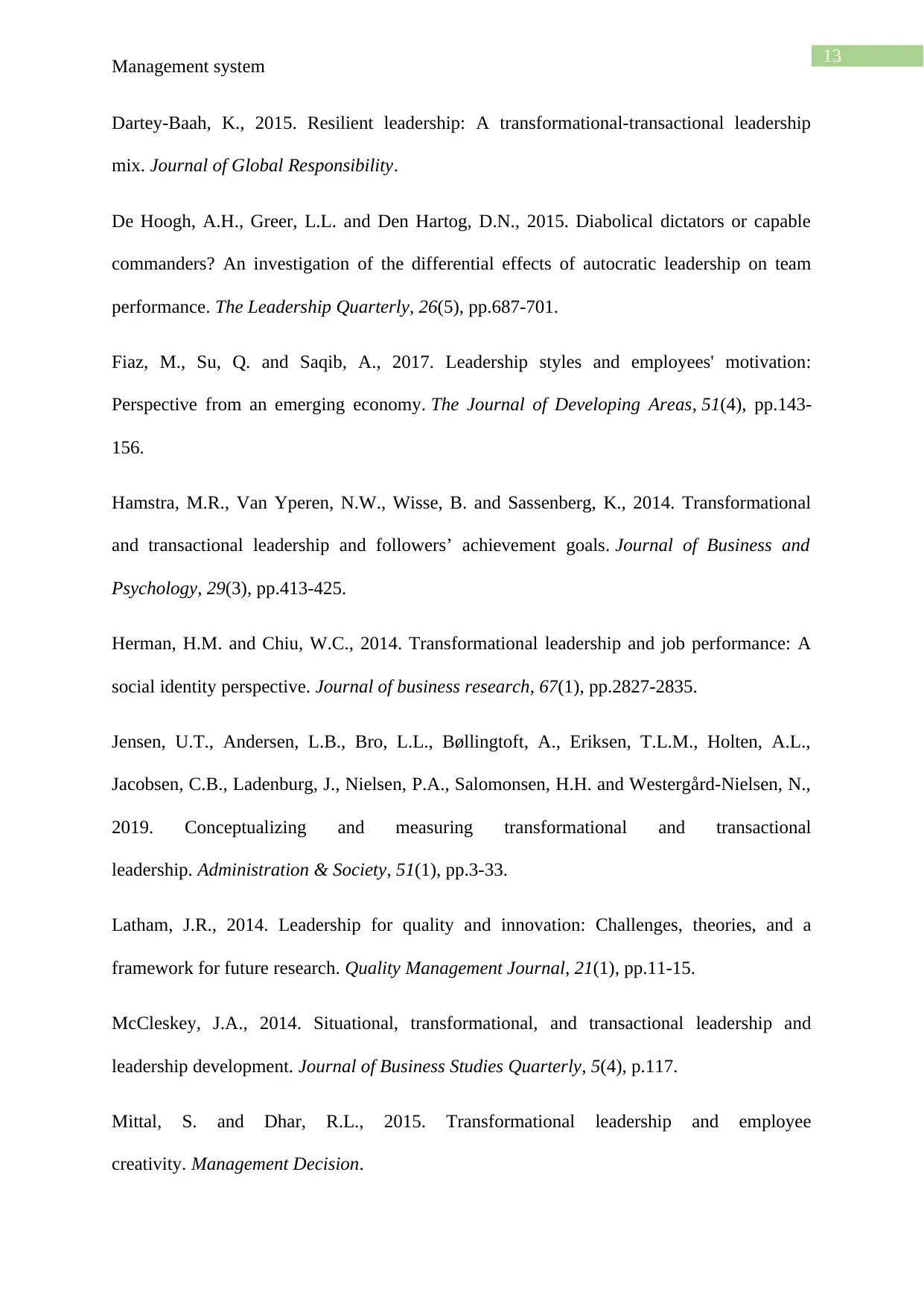
13
Management system
Dartey-Baah, K., 2015. Resilient leadership: A transformational-transactional leadership
mix. Journal of Global Responsibility.
De Hoogh, A.H., Greer, L.L. and Den Hartog, D.N., 2015. Diabolical dictators or capable
commanders? An investigation of the differential effects of autocratic leadership on team
performance. The Leadership Quarterly, 26(5), pp.687-701.
Fiaz, M., Su, Q. and Saqib, A., 2017. Leadership styles and employees' motivation:
Perspective from an emerging economy. The Journal of Developing Areas, 51(4), pp.143-
156.
Hamstra, M.R., Van Yperen, N.W., Wisse, B. and Sassenberg, K., 2014. Transformational
and transactional leadership and followers’ achievement goals. Journal of Business and
Psychology, 29(3), pp.413-425.
Herman, H.M. and Chiu, W.C., 2014. Transformational leadership and job performance: A
social identity perspective. Journal of business research, 67(1), pp.2827-2835.
Jensen, U.T., Andersen, L.B., Bro, L.L., Bøllingtoft, A., Eriksen, T.L.M., Holten, A.L.,
Jacobsen, C.B., Ladenburg, J., Nielsen, P.A., Salomonsen, H.H. and Westergård-Nielsen, N.,
2019. Conceptualizing and measuring transformational and transactional
leadership. Administration & Society, 51(1), pp.3-33.
Latham, J.R., 2014. Leadership for quality and innovation: Challenges, theories, and a
framework for future research. Quality Management Journal, 21(1), pp.11-15.
McCleskey, J.A., 2014. Situational, transformational, and transactional leadership and
leadership development. Journal of Business Studies Quarterly, 5(4), p.117.
Mittal, S. and Dhar, R.L., 2015. Transformational leadership and employee
creativity. Management Decision.
Management system
Dartey-Baah, K., 2015. Resilient leadership: A transformational-transactional leadership
mix. Journal of Global Responsibility.
De Hoogh, A.H., Greer, L.L. and Den Hartog, D.N., 2015. Diabolical dictators or capable
commanders? An investigation of the differential effects of autocratic leadership on team
performance. The Leadership Quarterly, 26(5), pp.687-701.
Fiaz, M., Su, Q. and Saqib, A., 2017. Leadership styles and employees' motivation:
Perspective from an emerging economy. The Journal of Developing Areas, 51(4), pp.143-
156.
Hamstra, M.R., Van Yperen, N.W., Wisse, B. and Sassenberg, K., 2014. Transformational
and transactional leadership and followers’ achievement goals. Journal of Business and
Psychology, 29(3), pp.413-425.
Herman, H.M. and Chiu, W.C., 2014. Transformational leadership and job performance: A
social identity perspective. Journal of business research, 67(1), pp.2827-2835.
Jensen, U.T., Andersen, L.B., Bro, L.L., Bøllingtoft, A., Eriksen, T.L.M., Holten, A.L.,
Jacobsen, C.B., Ladenburg, J., Nielsen, P.A., Salomonsen, H.H. and Westergård-Nielsen, N.,
2019. Conceptualizing and measuring transformational and transactional
leadership. Administration & Society, 51(1), pp.3-33.
Latham, J.R., 2014. Leadership for quality and innovation: Challenges, theories, and a
framework for future research. Quality Management Journal, 21(1), pp.11-15.
McCleskey, J.A., 2014. Situational, transformational, and transactional leadership and
leadership development. Journal of Business Studies Quarterly, 5(4), p.117.
Mittal, S. and Dhar, R.L., 2015. Transformational leadership and employee
creativity. Management Decision.
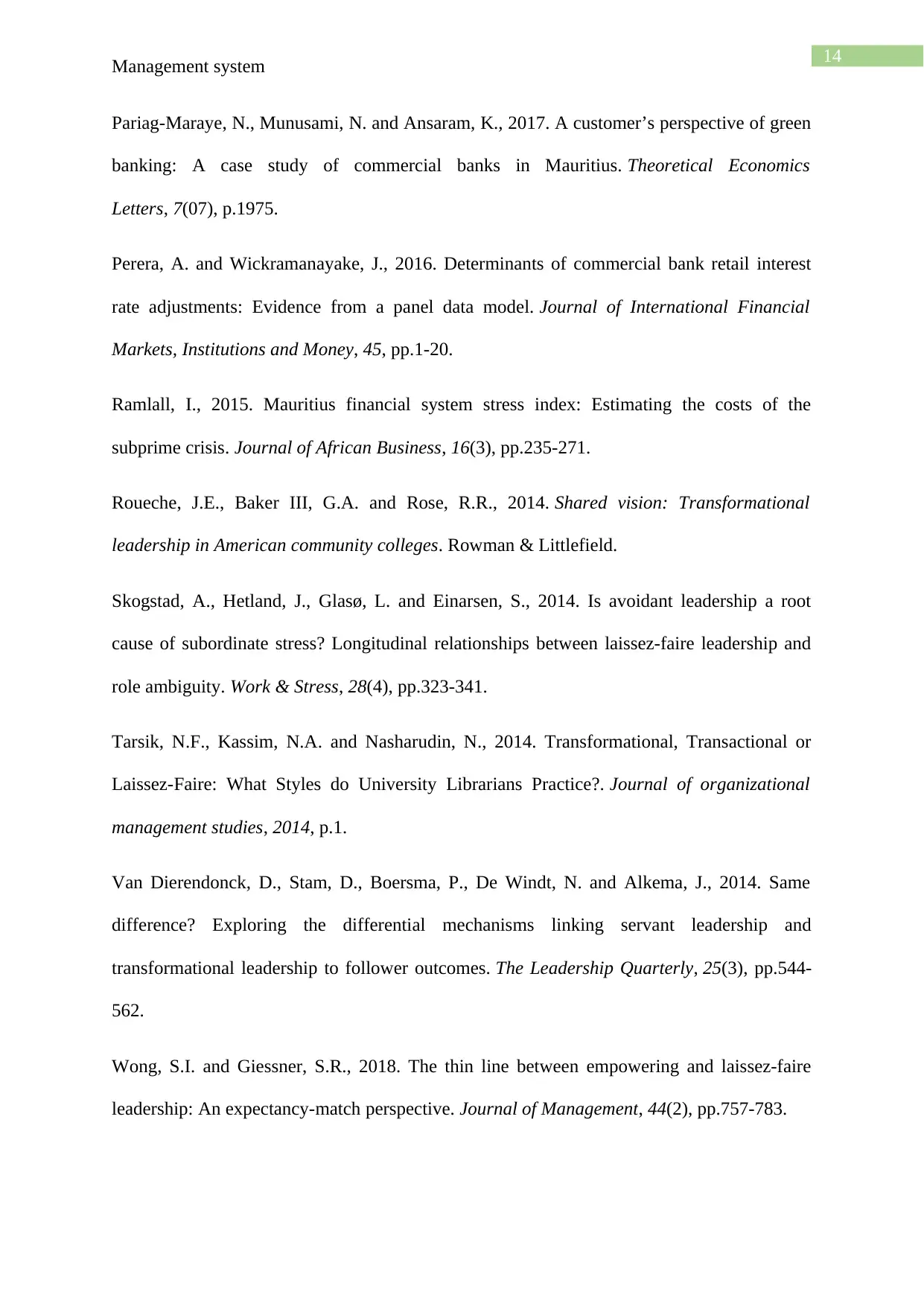
14
Management system
Pariag-Maraye, N., Munusami, N. and Ansaram, K., 2017. A customer’s perspective of green
banking: A case study of commercial banks in Mauritius. Theoretical Economics
Letters, 7(07), p.1975.
Perera, A. and Wickramanayake, J., 2016. Determinants of commercial bank retail interest
rate adjustments: Evidence from a panel data model. Journal of International Financial
Markets, Institutions and Money, 45, pp.1-20.
Ramlall, I., 2015. Mauritius financial system stress index: Estimating the costs of the
subprime crisis. Journal of African Business, 16(3), pp.235-271.
Roueche, J.E., Baker III, G.A. and Rose, R.R., 2014. Shared vision: Transformational
leadership in American community colleges. Rowman & Littlefield.
Skogstad, A., Hetland, J., Glasø, L. and Einarsen, S., 2014. Is avoidant leadership a root
cause of subordinate stress? Longitudinal relationships between laissez-faire leadership and
role ambiguity. Work & Stress, 28(4), pp.323-341.
Tarsik, N.F., Kassim, N.A. and Nasharudin, N., 2014. Transformational, Transactional or
Laissez-Faire: What Styles do University Librarians Practice?. Journal of organizational
management studies, 2014, p.1.
Van Dierendonck, D., Stam, D., Boersma, P., De Windt, N. and Alkema, J., 2014. Same
difference? Exploring the differential mechanisms linking servant leadership and
transformational leadership to follower outcomes. The Leadership Quarterly, 25(3), pp.544-
562.
Wong, S.I. and Giessner, S.R., 2018. The thin line between empowering and laissez-faire
leadership: An expectancy-match perspective. Journal of Management, 44(2), pp.757-783.
Management system
Pariag-Maraye, N., Munusami, N. and Ansaram, K., 2017. A customer’s perspective of green
banking: A case study of commercial banks in Mauritius. Theoretical Economics
Letters, 7(07), p.1975.
Perera, A. and Wickramanayake, J., 2016. Determinants of commercial bank retail interest
rate adjustments: Evidence from a panel data model. Journal of International Financial
Markets, Institutions and Money, 45, pp.1-20.
Ramlall, I., 2015. Mauritius financial system stress index: Estimating the costs of the
subprime crisis. Journal of African Business, 16(3), pp.235-271.
Roueche, J.E., Baker III, G.A. and Rose, R.R., 2014. Shared vision: Transformational
leadership in American community colleges. Rowman & Littlefield.
Skogstad, A., Hetland, J., Glasø, L. and Einarsen, S., 2014. Is avoidant leadership a root
cause of subordinate stress? Longitudinal relationships between laissez-faire leadership and
role ambiguity. Work & Stress, 28(4), pp.323-341.
Tarsik, N.F., Kassim, N.A. and Nasharudin, N., 2014. Transformational, Transactional or
Laissez-Faire: What Styles do University Librarians Practice?. Journal of organizational
management studies, 2014, p.1.
Van Dierendonck, D., Stam, D., Boersma, P., De Windt, N. and Alkema, J., 2014. Same
difference? Exploring the differential mechanisms linking servant leadership and
transformational leadership to follower outcomes. The Leadership Quarterly, 25(3), pp.544-
562.
Wong, S.I. and Giessner, S.R., 2018. The thin line between empowering and laissez-faire
leadership: An expectancy-match perspective. Journal of Management, 44(2), pp.757-783.
1 out of 15
Your All-in-One AI-Powered Toolkit for Academic Success.
+13062052269
info@desklib.com
Available 24*7 on WhatsApp / Email
![[object Object]](/_next/static/media/star-bottom.7253800d.svg)
Unlock your academic potential
© 2024 | Zucol Services PVT LTD | All rights reserved.




